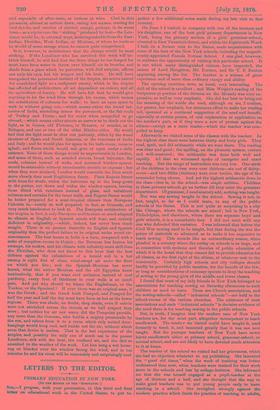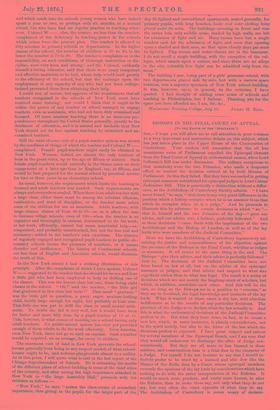LETTERS TO THE EDITOR.
PRIMARY EDUCATION IN NEW YORK. Ito mHa SDITOR OF Till "SPECTATOR" • propose, with your permission, in this third and final letter on educational work in the United States, to put to-
gether a few additional notes made during my late visit to that country.
On June 5 I visited, in company with one of the trustees and his daughter, one of the best girls' primary departments in New York, being the primary section of a girls' grammar-school, situated in East Twentieth Street, and within the Eighteenth Ward. I had, on a former visit to the States, made acquaintance with some of the best of the New York schools, including the magnifi- cently-appointed Female Normal School I was glad, however, to embrace the opportunity of visiting this particular school It is one which many distinguished visitors have inspected, the names of Lord Houghton, Mr. Forster, and Sir T. F. Buxton appearing among the list. The teacher is a woman of great experience and of more than ordinary energy and ability.
The opening exercises were, as usual, very interesting. The drill of the school is excellent ; and Miss Wright's reading of the Scriptures (a portion of the Sermon on the Mount) was very ex- pressive, as well as very emphatic. She did her beat to bring out the meaning of the words she read, although on me, I confess, her pauses, her emphasis, her strenuous effort to make her reading tell, operated as a continual suggestion of the need and benefit, especially at certain points, of oral explanation or application on the teacher's part, as if they were a sort of protest against the silence—except as a mere reader—which the teacher was com- pelled to keep.
Afterwards we visited some of the classes with the teacher. In the highest class there were between thirty and forty girls. They read, spelt, and did arithmetic while we were there. The reading was clear and good ; the spelling, on the phonetic system, correct and well-mastered ; the arithmetic was done both well and rapidly. All that we witnessed spoke of energetic and exact teaching. But the range of instruction was very low. One-sixth of the children in the class were over thirteen—six out of thirty- seven—and two-fifths (thirteen) were over twelve, the age of the remainder being eleven. And yet the highest arithmetic done in the class—that is, in the school—was simple addition. Children in these primary schools go no farther till they enter the grammar department. Of grammar, I need scarcely add, nothing was taught.
Nor was any sewing taught in the school. Sewing is not, in fact, taught, so far as I could learn, in any of the public- • schools of the States. This is not quite so surprising in a city like Chicago, where the schools are mixed ; but in New York, Philadelphia, and elsewhere, where there are separate boys' and girls' schools, it is a remarkable fact. I did not meet with any- one who defended this omission. I was informed that before the Civil War sewing used to be taught, but that during the war the prices of materials so advanced as to make it too expensive to teach sewing. This sounds like an extraordinary reason, when pleaded in a country where the outlay on schools is so large, and in connection with systems and theories of public education of which it is the boast that they cannot fail to provide education for all classes, as the first right of the citizen, at whatever cost to the community. Certainly high schools and city colleges should hardly be provided by public taxation, for the benefit of the few, so long as considerations of economy operate to deny the teaching of sewing to the young girls of the middle and lower classes.
I found that most of my lady friends in New York belonged to associations for teaching sewing on Saturday afternoons to such children as need to learn. These are Church associations, and the sewing-schools—called " industrial schools "—are held in the school-rooms of the various churches. The existence of such associations and such "industrial schools " is decisive evidence of the need there is for teaching sewing in the public schools.
But, in truth, I imagine that the modern race of New York teachers are, for the most part, altogether incompetent to teach needlework. The teacher we visited could have taught it, used formerly to teach it, and lamented greatly that it was not now taught. But the younger teachers of New York have never learnt needlework either at primary school, grammar-school, or normal school, and are not likely to have devoted much attention to it at home.
The teacher of the school we visited bad her grievances, which she had no objection whatever to my publishing. She lamented the "good old times," when the work of teaching was better understood than now, when teachers were trained for their work more in the schools and less by college-lectures. She informed me that she was herself engaged as a pupil-teacher at the age of thirteen and a half, and she thought that the way to make good teachers was to put young people early to learn teaching in a school. She inveighed strongly against the modern practice which limits the practice of teaching to adults, and which sends into the schools young women who have indeed spent a year or two, or perhaps only six months, at a normal school, but who have had no regular practice in teaching what- ever. Colonel W—, also, the trustee, no less than the teacher, complained of the deficiency in teaching-power in the schools which arises from the present plan. One teacher is allowed to fifty scholars in primary schools or departments. In the higher classes of the school, the number of children is 30 to 40, in the lower the number is 70 to 80. The teacher's complaints as to the impossibility, on such conditions, of thorough instruction or dis- cipline, were very keen and strong ; and the Colonel, evidently himself a loving educator, said that there were many competent and effective assistants to be had, whose help would tend greatly to the efficiency of the school, but that the embargo upon the employment in any capacity of any who had not been college- trained prevented them from obtaining their help.
I could not, of course, but approve of the requirement that all teachers recognised in the schools of New York must have received some training ; nor could I think that it ought to be within the power of any teacher or school manager to engage teachers, even as assistants, who had not been duly examined and licensed. Of mere amateur teaching there is an immense pre- ponderance throughout the United States generally, greatly to the detriment of education, and it is natural and laudable that New York should set its face against teaching by untrained and un- examined teachers.
Still the want of some sort of a pupil-teacher system was shown by the condition of things of which the teacher and Colonel W complained. Female pupil-teachers might easily be obtained in New York. Women, indeed, are almost the only teachers of boys in the great cities, up to the age of fifteen or sixteen. Such female pupil-teachers would naturally in the States enter on their engagement at a later age than in England, say, at fifteen, and would be best prepared for the normal school by practical service for two or three years in an elementary school.
As usual, however, the requirement which limits the teaching to licensed and adult teachers was evaded. Such requirements are always and everywhere evaded. When there is an adult teacher with a large class, either there must be among the scholars idleness, inattention, and want of discipline, or the teacher must select some of the children for use as monitors. Adult teachers, with large classes, classes of from 40 to 70—or, as is often the case in German village schools, even of 100—when the teacher is an organiser and thoroughly in earnest, determined to do his work, or her work, efficiently, cannot but mean monitorial help—ex- temporised, and probably unauthorised, but not the less real and necessary—added to the teacher's own exertions. The absence of regularly engaged and recognised pupil-teachers in public ele- mentary schools means the presence of monitors, or it means disorder and inefficiency. The history of Continental schools, not less than of English and American schools, would illustrate the truth of this.
principle. After the complaints of which I have spoken, Colonel W— suggested to the teacher that she should let me see and hear a little girl who had been employed to help in drilling one of the classes. This was the lowest class but one, there being eight classes in the school. " Oh !" said the teacher, " the little girl that graduated in this class last term ?" That small " graduate " was the little girl in question, a puny, eager, anxious-looking child, hardly large enough for eight, but probably at least nine. This little one was put to drill the class in small mental arith- metic. No doubt she did it very well, but it would have been far better and more fitly done by a pupil-teacher of 14 or 15. This, however, is what comes of insisting on a school having only adult teachers. No public-school system has ever yet provided enough of these adults to do the work efficiently. Even America, even New York, dares not go to such an expense. Such a teacher would be required, on an average, for every 35 children.
The enormous cost of land in New York prevents the school- houses generally from being in any respect models of what school- houses ought to be, and reduces playgiounds almost to a nullity. As to this point, I will quote what is said in the last report of the Chicago Superintendent of Schools. He is estimating the merits of the different plans of school-building in some of the chief cities of the country, and after noting the high importance attached in New York to " tne large Assembly Hall," proceeds with his criticism as follows :— " New York," he says, "makes the class-rooms of secondary importance, thus giving to the pupils for the larger part of the
day ill-lighted and unventilated apartments, seated generally, for !primary pupils, with long benches, books and outer clothing being placed under the seats. The buildings covering in front and rear the entire lots, only middle areas, shaded by high walls, are left for admission of light and air. Many rooms have but a single window each for the admission of light, and even that opening upon a shaded and dark area, so that upon cloudy days gas must be lighted. Play-rooms and water-closets are in the basement. 1 do not recall a single building, with the exception of the col- leges, which stands upon a corner, and since there are no alleys in the city, tolerably free light can be admitted only from the front."
The building I saw, being part of a girls' grammar-school, with two departments placed side by side, but with a narrow space between, was a superior specimen of New York school-building. It was, however, open, in general, to the criticism I have quoted. I had thought of adding some notes of scliools and teaching in Philadelphia, but I forbear. Thanking ybu for the space you have afforded me, I am, Sir, &c.,
Westminster Training College, July 10. JAMES H. RIOG.































 Previous page
Previous page